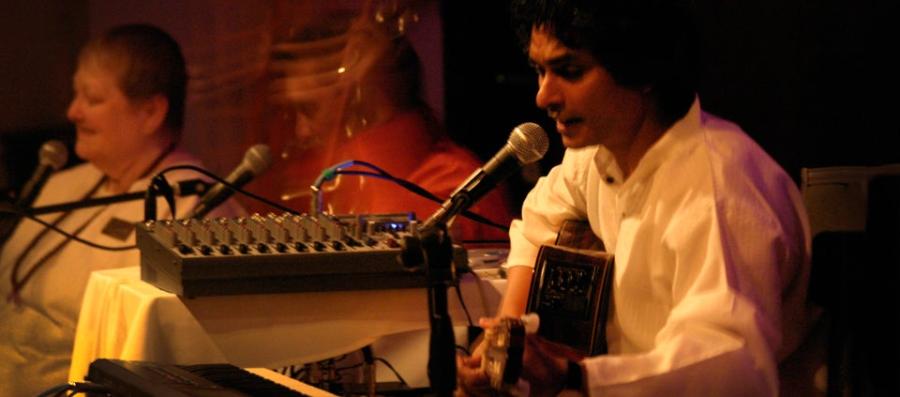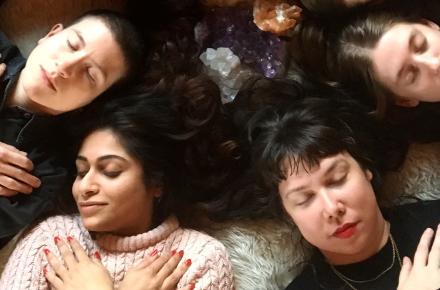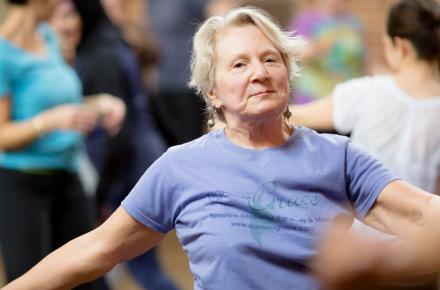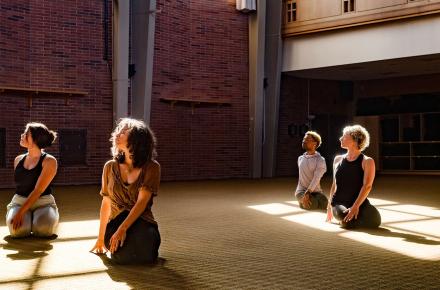Mantras, Creative Expression, and Healing

What do the ear and the voice have to do with our health? A lot more than you would expect! Developing our ears and our voice in simple ways can have real and lasting effects on our health and happiness. In many parts of the Western world, there is a rapidly growing awareness of sacred sound, including the Yoga of Sound, a tradition within Indian spirituality that has been in existence for many millennia.
Sound is also a medium for yoga, a means by which the goals of yoga can be realized. Furthermore, improved health and spiritual enlightenment can be attained through a deeper understanding of the inclusion of sound in our spiritual practice. With this in mind, not only can yogi practitioners benefit from such an inclusion, but non-yogis, too, since neither postures nor stretches are necessary to tap the goals of yoga through the medium of sacred sound. Yoga postures, however, can exponentially enhance the effects of sacred sound.
Today, there is a widespread interest in chanting within the American yoga community. Mantra chanting and kirtan (call-and-response chanting) have become forms of spiritual expression that bring practitioners together and transform yoga studios into places of worship. While celebrating the experience of yoga in sound and music is important for community building, yoga is also the type of practice that we also cultivate in private. There are aspects of sacred sound that should be known, understood, and applied in that context, and this understanding can be gleaned from the Yoga of Sound, also known as Nada Yoga, a path that is more than two thousand years old. According to yoga scholar Georg Feuerstein, the Yoga of Sound teachings might have influenced Patanjali, the father of classical yoga.
Chant has long been used in cultures around the world for healing and tapping deep spiritual states. Shamanism, for instance, has used sound as its primary means to change the consciousness of a person who is ill into someone who is free of illness. And Benedictine monks have chanted for 1,500 years for their spiritual well-being, without realizing that the benefits were physical and mental as well. When one Benedictine community in France cut out chanting from their daily schedule, the monks who had worked hard on the land for decades started to fall ill. This was rectified the moment that chant was reintroduced by the renowned physician Alfred Tomatis, who was called in to treat the monks. Tomatis has contributed immeasurably to our understanding of the relationship of the ear and the voice to our health.
The Role of Creativity in the Use of Sacred Sound and Mantra
Creativity is in itself a form of healing. Mantras, too, are a form of healing. How, then, do we bring the two together—mantras and creativity?
Health is not simply the absence of disease: It is a condition of soul that invigorates our being, enabling us to derive the most from life. Additionally, the effects of yoga as well as sound vibrations upon our health and well-being have garnered enormous credibility in recent decades. What if we could combine the two to bring about wholeness? That’s the idea behind the Yoga of Sound, a tradition of sacred sound that intersects intimately with the development of yoga in Indian spirituality. The Yoga of Sound embraces it all—mantras, kirtans, and more. Although it should be noted that this tradition, in its most ancient form, was more about listening and attunement to subtle sounds than about making sounds or using mantras.
Mantras, primarily, were not designed to be expressed creatively, at least not in the way they are presently being set to music in the West. One common misconception is that kirtan and mantra are the same thing. Kirtan, generally, is not a mantra. Nor is kirtan a mantra set to music, as commonly assumed. Mantras, for the most part, are not sung, but uttered, muttered, whispered, or recited mentally. If chanted aloud, only a few musical tones are utilized. Nevertheless, certain types of mantras do lend themselves to creative expression.
The first thing that most people say about mantras is that they are meant to be repeated. This is true of a certain type of mantra but not all. Many mantras function like magical spells. They only need to be uttered once. And there is a tremendous effect as a result, much like in a Harry Potter book. Obviously, the effect of such mantras lie in their proper utterance, which is why wizard apprentices (and mantra apprentices) go to school: Hogwarts for the former, a Veda Patashala, or Vedic mantra school, for the latter. Proper mantra study, traditionally, took 12 years.
There is another category of mantras—those deriving from the Tantric tradition. Some of these mantras lend themselves to creativity, especially for the Western musician. This is usually the type of mantra that is repeated in order to “release” the effect progressively. The Tantric tradition, however, is rather secretive, and its mantras are taught only through initiation. The mantras that most lend themselves to creativity are mantras from the Bhakti tradition, “bhakti” meaning devotion. These are also known as “puranic” mantras. They are the names of gods and goddesses that often contain important characteristics of these deities and preserve the sacred stories around these deities. Before you launch into mantras and creativity, a general rule of thumb is to know which category a mantra belongs in before getting creative with it, since there are rules that govern mantras and, in many contexts, ignoring these rules constitutes disrespect, even sacrilege.
Ways to Work Creatively with Devotional Mantras
There are several ways in which devotional mantras can be expressed creatively. First, there is the method of using just a few tones. For instance, with the classic mantra “Om Namah Shiva ya,” you can use a base tone (not “bass” tone, mind you) as your reference, and this could be any tone or pitch you want it to be. Simply by varying the pitch on the syllables of the mantra, even just one or two other tones, you can be quite creative. This is also the easiest form of creativity with a mantra, which pretty much anyone can enjoy playing with, and it helps the mantra come alive. When a mantra “comes alive,” its energy and potency increase exponentially. And you can do this with or without rhythm, letting it flow any way you want without being constrained by tempo.
Another, slightly more involved approach, but requiring some musical knowledge, is to take a musical scale and use that as a reference to create a melody for the mantra. In Indian music, ragas are usually used for this purpose. Ragas are a sequence of musical intervals governed by specific rules. They can also relate to the time of day and season of the year. Western musical scales are not as involved as ragas, but just as good to create a mood of sadness or joy with the basic major or minor scale options. In this way, a mantra may be used to relieve us of painful energies and memories or to evoke joy and delight. Such expressions of our creativity then become a means of healing. In other words, mantras can combine with music to create a harmonic result.
There is, finally, the rhythmic aspect. Mantras in general are rhythmic because they are constructed in meter, like poetry. A natural rhythm occurs in their syllabic structure which can be further developed into more complicated rhythms by the creative musician. However, non-musicians can just as easily tap the rhythmic nature of mantras, and through the rhythm tap their healing potency. For instance, with the classic mantra “Sri Rama Jaya Jaya Rama,” there is rhythm built into the natural flow of the syllables. Say it aloud and you will feel it entrain your thought processes, that is, sync them together harmoniously.
Entrainment is one of the reasons why mantras are so powerful, for they harmonize our thought patterns like pendulums moving in union when in proximity to one another. Ancient Hindus were acutely aware of entrainment many millennial ago, and it was documented in the 1600s by Dutch physicist Christiaan Huygens, opening up the possibilities of entrainment to the scientific community. Mantras are a spiritual technology that inherently possess the power to entrain and, in doing so, to facilitate healing of mind and body.
Find out about upcoming programs with Russill Paul at Kripalu.
© Kripalu Center for Yoga & Health. All rights reserved. To request permission to reprint, please e-mail editor@kripalu.org.





















































